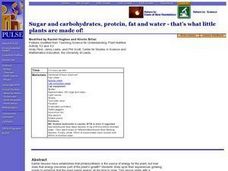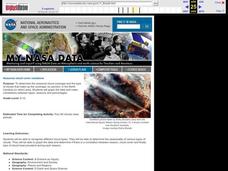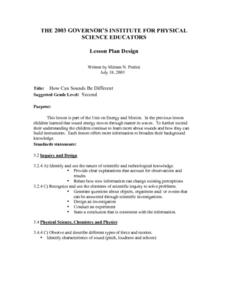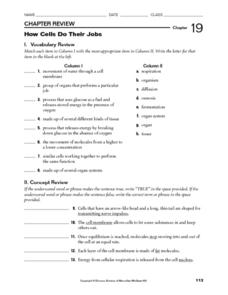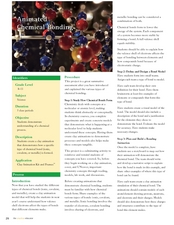Curated OER
Sugar and carbohydrates, protein, fat and water - that's what little plants are made of!
Students identify photosynthesis as the mechanism by which plants convert sunlight energy into a usable energy source for plant processes. They identify photosynthesis as the mechanism by which plants create a molecule that can be used...
Curated OER
Earthquake, Earthquake, Read All About It!
Pupils utilize the U.S. Geological Service web site. They research the various types of scales used to measure earthquakes and classify different situations on the scale. They write a story about a town that has just experienced a quake.
Curated OER
Shining the Light on Skin
Students investigate the relationships between certain environmental factors and levels of exposure to sunlight. The variables of location, time of year, and day, and the weather which affect the intensity of the sun are explored in this...
Curated OER
Photocells II: The Photoelectric Effect in Photocells
Students discuss the principles of atomic structure that underlie the operation of a photovoltaic cell and explains how they apply to a photovoltaic cell's operation. An area of the classroom is staked off to represent a photovoltaic...
Curated OER
Solving Practical Problems with Heats of Combustion
In this combustion worksheet, students calculate kJ obtained from combustion or the kJ used to fuel a car. Students use the heat of combustion of sugar and fat to determine the energy needed by the body. This worksheet has 1 short answer...
Curated OER
Dancing in the Desert: The Genie
Fifth graders study nuclear destruction using visual literacy. In this nuclear destruction lesson, 5th graders work in groups to examine a group of pictures that show the destruction of a home by a nuclear blast. They discuss the type of...
Curated OER
Electrical Battery
Young scholars investigate the different types of batteries and how they work. In this energy lesson students experiment with batteries and see which ones last the longest.
Curated OER
Comets
Young scholars explore the nature and composition of a comet. They research comet facts, legends, and myths. They identify different types of comets and describe what happens to a comet as it travels closer to the Sun.
Curated OER
Conductivity
Students work together to create a simple conductivity tester. They discover the difference between conductors and insulators. They test different types of materials for their conductivity as well.
Curated OER
It's in the Bag!
Eighth graders measure temperature changes and make drawings of the interactions between matter and energy. By measuring the temperature students can conclude if there are changes in levels of energy.
.
Curated OER
Seasonal Cloud Cover Variations
Students recognize different cloud types. They determine the seaonality of various types of clouds. They graph the data and determine if a correlation exists between season, cloud cover and type of clouds most prevalent during each season.
Curated OER
The Urban Heat Island Effect - Lesson 2 (Grades 8-9)
Learners use the scientific process to show that when various surfaces are exposed to similar environmental conditions, surface temperatures may vary. They examine the "urban heat island" phenomenon and analyze why it increases energy...
Curated OER
How Can Sounds Be Different
Second graders explore energy and motion. They investigate how sound energy moves in waves. Students explore how sounds are varied and how the instruments that make those sounds are built. They observe sounds being produced and predict...
Curated OER
What Color is Chlorophyll?
Students observe the interactions of chlorophyll and light. They develop and form their own testable hypotheses. Students predict the color of chlorophyll in various types of plants.
Curated OER
Oil Spill
Fourth graders watch a video about the types of products made from oil or oil used as energy to produce the product. In groups, they identify the positive and negative aspects of oil and participate in various activities. They use the...
Curated OER
Heat Misconceptions
Third graders determine that gloves do not provide heat, but rather, they insulate or hold in any heat that is in their hand. They discuss the different temperatures found in ecosystems around the world. What do animals that live in...
Curated OER
How Cells Do Their Jobs
In this cells learning exercise, students will review cell characteristics and structure and different types of cells and what role they play in the body. Students will investigate experimental results of the influence of sucrose on the...
Curated OER
Animated Chemical Bonding
Students demonstrate their understanding of a chemical process. In this exploratory lesson students create a clay animation that shows how a specific type of chemical bond.
Curated OER
Ocean: Waves
In this ocean waves instructional activity, 6th graders read 2 pages about different types of ocean waves, then answer 10 true or false questions. An answer key is provided.
Curated OER
Volcano!-Thar She Blows!
Middle schoolers describe how volcanoes are formed. They name the types of boundaries where volcanoes occur. They utilize models to illustrate the occurence of volcanoes and earthquakes along plate boundaries. They compare and constrast...
Curated OER
Earthquake Waves
In this waves instructional activity, students read about the different types of waves associated with earthquakes. Then students complete 1 fill in the blank and 2 short answer questions.
Curated OER
Observing Sea Ice
Students study and observe types of sea ice found in Alaska. In this sea ice lesson, students use the student network for observing weather to study the different types of sea ice. Students study sea ice depicted in Alaskan art.
Curated OER
Eating a Variety for Breakfast
Students describe different types of breakfasts they would like to eat. They make and eat breakfast food.
Curated OER
Fossil Fuel Scavenger Hunt
In this earth science activity, students complete each of the statements with the correct fossil fuel. They identify when and where electricity first became available. Students also define fossil fuels and where they first got their...
Other popular searches
- Types of Energy Sources
- Types of Energy Transfer
- Different Types of Energy
- Energy Types
- Definitions Types of Energy
- 7 Types of Energy
- 6 Types of Energy
- Types of Energy Website
- 7 Energy Types
- Types of Energy Cycles
- Energy Types Of


